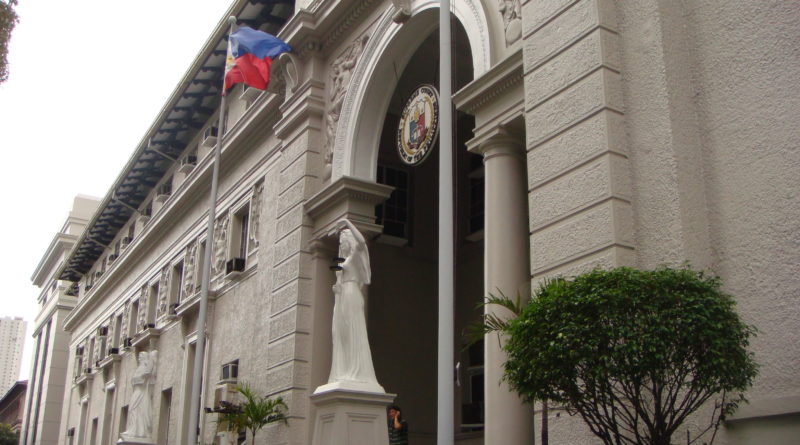COLUMN-OPINION: OPINION ON PAGE ONE – What if our problem is the singer, not the song? By Francisco Tatad
MANY of our Supreme Court justices seem to believe they have the right, the duty and the power to judicially remove the Chief Justice, whom President Rodrigo Duterte desperately wants out, in patent disregard of the Constitution, which provides that an impeachable officer, such as the President, the Vice President, members of the Supreme Court, members of the constitutional commissions and the Ombudsman, may be removed only upon conviction in a Senate impeachment trial, after having been impeached by the House of Representatives, with the concurrence of no less than two-thirds of all the senators.
An abomination
Even the village idiot knows this reported belief is arrant nonsense. The Supreme Court does not have the right, the duty or the power to review and reject the President’s appointment of a Chief Justice, or a mere associate justice, even by a unanimous vote. It is an abomination as far as common sense and the fundamental precepts and principles of the Constitution are concerned, and puts the justices above the Constitution and the court, which is the exact opposite of their proper place.
The manner of appointing our justices has evolved through various changes of our Constitution, but no Constitution ever allowed the justices to arrogate unto themselves a power they never had. The justices derive their authority and power from the Constitution and the court, rather than the Constitution and the court deriving their power and majesty from the consent and calculations of the justices. This is a permanent and unchanging doctrine.
Under Section 5, Article VIII of the 1935 Constitution, “all members of the Supreme Court and all judges of inferior courts are appointed by the President with the consent of the Commission on Appointments.” In the 1973 Constitution, which adopted a quasi-parliamentary system, the Prime Minister became the appointing power, without the participation of the Commission on Appointments, which was deleted from the structure.
Reviewing appointments
But neither in the 1935 nor in the 1973 Constitution, was the high court involved in the screening, naming and qualifying of justices. The court en banc never reviewed the appointment of any justice.
Under the present Constitution, the President appoints justices without need of CA confirmation, from a list of at least three nominees submitted by a seven-man Judicial and Bar Council chaired by the Chief Justice for every vacancy that needs to be filled. The JBC and only the JBC nominates, and the President appoints the justices from among the nominees.
Somehow the President’s preference always manages to land on the JBC “short list.” But although the Chief Justice chairs the JBC, whose principal function it is to recommend judicial appointees, the SC does not get involved in vetting prospective appointees, nor in reviewing SC appointments. After a justice is appointed, he or she may be removed from office only by death, permanent disability, resignation, or impeachment for, and conviction of, culpable violation of the Constitution, treason, bribery, graft and corruption, other high crimes or betrayal of public trust.
This means that even if we were all agreed that Maria Lourdes Sereno’s appointment was an exceptional case of bad judgement on the part of then President B. S. Aquino 3rd, who may have wanted to buy some kind of legal insurance for the next 20 years; even if Sereno were guilty of all the accusations levelled against her, including charges of being bipolar and psychologically unfit, her colleagues could still not amend the Constitution and give themselves a power that is not theirs just to get rid of a disagreeable and unwanted chief. Her removal is not the business of her colleagues. It is for the Senate and only for the Senate to try her in an impeachment trial, if and when she is finally impeached by the House of Representatives.
Who are they to judge?
The 14 other justices are made up of two kinds: those who were appointed before Sereno became chief justice, and those who were appointed afterward. If those already in office before Aquino made Sereno chief justice have no power to review and reject her appointment, how much more those who joined the court after she was appointed? The answer is obvious. And yet it was Associate Justice Noel Tijam, a recent DU30 appointee, who drafted the ponencia reportedly ousting Sereno, even before the court en banc could hear the oral arguments on the Solicitor General’s quo warranto initiative.
This is not all. There are reports from legal circles close to Malacañang, unverified as of now and hopefully untrue, that the latest plan being mooted among some pro-DU30 bright boys is to declare Sereno’s appointment as void ab initio—like an invalid marriage that never existed. If these reports are true, it means the justices will have to proclaim she was never Chief Justice, through a declaration of nullity. I cannot see how this could fly, since it would mean invalidating Sereno’s vote in so many cases in which she had participated, and vacating decisions she may have penned.
These would include what I firmly believe was a patently erroneous decision on the patently unconstitutional Reproductive Health Law, which Sereno and others ruled as “not unconstitutional” despite its abject violation of the Constitution, which I pointed out during the oral arguments before the SC en banc but which was never refuted but simply ignored by the justices; and the laughable ruling in the case of a famous foundling whom Sereno and others decided was a natural-born Filipino on the basis of the Solicitor General’s presentation of statistical probabilities despite the clear citizenship provisions of the Constitution which supported the opposite view.
Beyond repair
Therefore, I doubt the justices would pursue the nullity option. But highly informed sources who claim to have an inside track on what’s happening at the court insist that more than a simple majority of the justices are ready to oust Sereno. This would not just be a mistake. It would be a catastrophe beyond repair. The justices, whose feet are all of clay, can err as they have in reading the clearest constitutional provision and the court can still survive their error; but in this particular case, there is no constitutional provision to misread, absolutely no written text to misinterpret, only the justices’ intense desire to get rid of their Chief Justice allows them to believe they have the right, the duty and the power to rule on an issue which is denied to them by the Constitution.
Against the Supreme Court’s patently erroneous and harmful decisions there is ultimately no appeal. And since a ruling ousting Sereno would fulfill DU30’s most fervent demand, the justices would have nothing to fear from a President who threatens to jail international legal servants who dare speak to him of human rights. After the court rules, assuming it will rule as feared, some lawyers will probably say we must continue to respect the court despite its error, for it is always right even when it is wrong. But if and when that happens, this ageing poor former public servant will have to summon every inch of courage and strength to tell his grandchildren that all law and justice have died in the country, and that we will have to fight our political and legal battles by other means.
The final blow
The next step for DU30 could be to declare his long desired “revolutionary government” and wipe out the last shreds of civility of political life under the Constitution. He has been heard recently to say this, and despite his tendency to say one thing and do another, those who were listening to him at close range seem convinced this is his ultimate aim, since he cannot seem to manage exercising limited and publicly accountable power within a well-defined constitutional order. This thought is a source of continuing nightmare for me, and I’m sure for many others.
But my greatest nightmare, from which I sometimes fear I may not be able to recover, is this: what happens when our long slumbering people finally awaken and decide that DU30 is correct after all, that indeed only a revolutionary government can cure our cancer, except that it should be run not by DU30 and his communist confreres, but by our long suffering people?
/ All photographs, news, editorials, opinions, information, data, others have been taken from the Internet ..aseanews.net | [email protected] |.For comments, Email to :D’Equalizer | [email protected] | Contributor.










